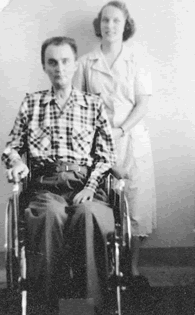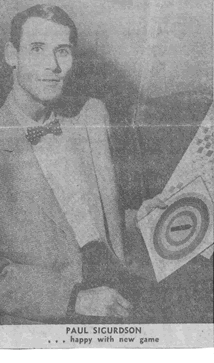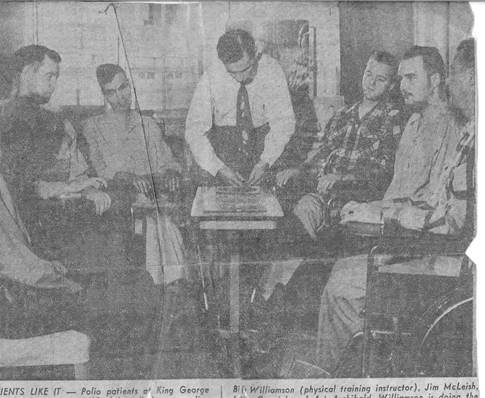Agnes Giesbrecht
Back to Members' Stories Home Page
Ten year old Agnes Hall was on her way home from Sunday school in the small community of Minitonas, MB. Agnes had done something during Sunday school that resulted in a reprimand from the teacher. One of Agnes' sisters was always the first one out the door to beat everyone home. Agnes was running full tilt, concentrating on getting home before her sister could tell on her. As Agnes crossed the highway she was hit by a truck driven by a local Forest Ranger. The impact tossed her the distance between two telephone posts. Passing neighbours rushed an unconscious Agnes to the hospital in Swan River where she was diagnosed with a broken knee, a broken hip and the back of her head cut open. No one could believe that she lived. Approximately 15 years later another of her sisters, Joan, was training as a nurse at the Health Sciences Centre. The patients in one room were asking where she lived as she said she was off home. The next morning one of the men was gone. The other men said to Joan, "You got hit by a truck when you were a little girl." Joan said, "No, that was my sister, but how do you know?" They said that the man who was no longer in their room was the man who hit her sister, a Forest Ranger from Minitonas.
Two of Agnes' older sisters worked at the Municipal Hospitals during the devastating flood of April 21, 1950. The Red River had risen to a disastrous level, immersing two and half square miles of the city under water that didn't subside until June 1st. Nurses had to travel from the residence to the hospital in row boats. Lenore worked in housekeeping and Helen worked as a telephone operator, both at the King Edward Hospital.
Nine years after her brush with death, Agnes' story comes full circle, and right into the aftermath of the Polio Epidemic in 1955. A friend of Lenore's and Helen's lived on Fisher Street, walking distance to the hospital, so they asked if their younger sister, Agnes could room with them as she had just been hired as a ward aide at the King George. After one day of training, she learned how to handle and care for the Polio survivors: washing faces and hands, brushing teeth and shaving (as she would be working mostly with the men). There were two young women from Virden, MB on that ward, but she didn't work with them. Another crucial part of their training was to experience the insides and workings of an iron lung. Nobody wanted to volunteer for that, but Agnes eventually gave in and agreed to do it. She described the rubber collar that the patient's head was squeezed through, the way the machine moved the body up and down, and reported how frightening and claustrophobic the whole experience was.
Some specific duties and experiences that Agnes recalled were:
- Setting the speed on "rocking beds"; standing guard to make sure the patient was okay.
- A Polio survivor from the US came home to Winnipeg. He taught many patients about "Frog Breathing". Prior to learning this new technique of taking in extra air, most of the men spoke very slowly and laboriously, or not at all. Once they got the hang of it, they communicated more freely, and had fun with it. Agnes recalled how that some days it did sound like a bunch of frogs in a pond!
- One evening shift, a couple of patients were brought in from Brandon to be put into iron lungs. It wasn't long until they wouldn't let anyone else besides Agnes and her coworkers put them in the iron lungs and take them out. The girls knew how irritated and raw the patient's skin became from rubbing on the insides of the machine, so they devised padding as buffers at all pressure points which kept the men comfortable all night long.
 |
One man, Mike Gennick (in the photo with Agnes) wouldn’t let anyone touch him for any reason. All the other guys on the ward laughed and teased her, knowing how stubborn Mike was. “He won’t let you do anything!” Agnes was soft spoken and gentle so Mike soon learned to trust her to comb his hair and shave his face. Mike’s wife and young daughter visited often and remarked how well Agnes had taken care of him |
| Other men in the photo, all patients of Agnes’ are L to R: Lee Mason, Alex Simpson, Burt Burman, Bill Williamson (physical therapist), Jim McLeish, Mike Gennick, Art Archibald. Bill is showing them how to play the game Curl-Away created by Paul Sigurdson in separate photo (at right). |
 |
 |
|
- Agnes had to walk the tunnels from the King George to the Princess Elizabeth hospitals to take the men for their physio therapy which included hot foments – a hot, damp woolen material which was placed on the muscles to loosen them up.
- It was a bit eerie walking through the older tunnel from the King George as they had to pass the morgue. Once they got into the newer part of the tunnel going into the Princess Elizabeth, it was much brighter with a smoother floor and painted walls.
- Another task for Agnes and her co-workers was to stand guard while each man was strapped to a large upright wooden table standing outside their rooms. Assisted by big, burly orderlies, the men were strapped on, and left there until they couldn’t stand any longer. The girls’ job was to stand beside them and make sure they didn’t fall. The purpose of this therapy was to help the men breathe easier.
- One of Agnes’ favourite tasks was to take the patients out for a fresh air stroll on the hospital grounds – a relaxing treat for all.
- Just last year Agnes saw a newspaper article about David Borthistle turning 80, and realized that they had been the same age when he was one of her patients in 1955.
- To-date, David is the sole Polio survivor from the 1953 epidemic still residing at Riverview Health Centre here in Winnipeg.
As I write this, I am reminded how blessed I am to be a Polio survivor myself, and even though having been totally paralyzed and in an iron lung for three weeks and given those smelly hot foments at age four, I didn't have to endure what those men did.
I am more vividly reminded what a blessing Agnes was to those patients as for the two years (1955 - 1957) that she worked there, she displayed compassion and caring with the gentleness of an angel. There were many such angels during those traumatic years, and our gratitude goes out to them all. We would not be the survivors that we are today without those unconditional helping hands.
Agnes still has that gift as she often helps and encourages other tenants and their families. As we started chatting about our lives and getting to know each other as neighbours, our stories converged, forming a kinship that no one could have imagined.
